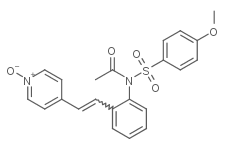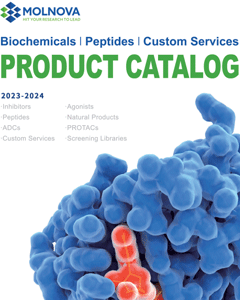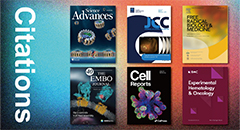
HMN214
CAS No. 173529-46-9
HMN214( HMN214 | HMN 214 | HMN-214 )
Catalog No. M17370 CAS No. 173529-46-9
HMN-214(IVX214) is a potent PLK1 inhibitor with an average IC50 of 0.12 μM.
Purity : >98% (HPLC)
 COA
COA
 Datasheet
Datasheet
 HNMR
HNMR
 HPLC
HPLC
 MSDS
MSDS
 Handing Instructions
Handing Instructions
| Size | Price / USD | Stock | Quantity |
| 2MG | 43 | In Stock |


|
| 5MG | 69 | In Stock |


|
| 10MG | 113 | In Stock |


|
| 25MG | 207 | In Stock |


|
| 50MG | 332 | In Stock |


|
| 100MG | 478 | In Stock |


|
| 500MG | 1062 | In Stock |


|
| 1G | Get Quote | In Stock |


|
Biological Information
-
Product NameHMN214
-
NoteResearch use only, not for human use.
-
Brief DescriptionHMN-214(IVX214) is a potent PLK1 inhibitor with an average IC50 of 0.12 μM.
-
DescriptionHMN-214 is an oral prodrug of HMN-176, a stilbene derivative that interferes with the subcellular spatial location of polo-like kinase-1, a serine/threonine kinase that regulates critical mitotic events.(In Vitro):HMN-214 is a prodrug of HMN-176. HMN-176 shows potent activities against 22 human tumor cell lines, with a mean IC50s of 118 nM. HMN-176 (3-300 nM) inhibits luciferase expression driven by the MDR1 promoter in a dose dependent manner in HeLa cells. HMN-176 (30-3000 nM) also dose-dependently suppresses complex formation on the Y-box. HMN-214 (3.3 μM) enhances luciferase expression relative to vehicle control with the 1,4C-1,4Bis polymer (11-fold) and PEI (37-fold) in PC3-PSMA cells. HMN-214 (≥ 3.3 μM) significantly reduces cell proliferation, causes considerable changes in cell morphology in MB49 cells.(In Vivo):HMN-214 (33 mg/kg, p.o.) converts to HMN-176 in rats. HMN-214 has no effect on the conduction velocity and the amplitude of action potentials in the aciatic and tibial nerves. HMN-214 (20 mg/kg, p.o.) exhibits antitumor activity in mice. HMN-214 (10, 20 mg/kg, p.o.) decreases MDR1 mRNA expression in nude mice bearing KB- and KB-A.1.-derived tumors.
-
In VitroHMN-214 is a prodrug of HMN-176. HMN-176 shows potent activities against 22 human tumor cell lines, with a mean IC50s of 118 nM. HMN-176 (3-300 nM) inhibits luciferase expression driven by the MDR1 promoter in a dose dependent manner in HeLa cells. HMN-176 (30-3000 nM) also dose-dependently suppresses complex formation on the Y-box. HMN-214 (3.3 μM) enhances luciferase expression relative to vehicle control with the 1,4C-1,4Bis polymer (11-fold) and PEI (37-fold) in PC3-PSMA cells. HMN-214 (≥ 3.3 μM) significantly reduces cell proliferation, causes considerable changes in cell morphology in MB49 cells.
-
In VivoHMN-214 (33 mg/kg, p.o.) converts to HMN-176 in rats. HMN-214 has no effect on the conduction velocity and the amplitude of action potentials in the aciatic and tibial nerves. HMN-214 (20 mg/kg, p.o.) exhibits antitumor activity in mice. HMN-214 (10, 20 mg/kg, p.o.) decreases MDR1 mRNA expression in nude mice bearing KB- and KB-A.1.-derived tumors.
-
SynonymsHMN214 | HMN 214 | HMN-214
-
PathwayMicrobiology/Virology
-
TargetHIV
-
RecptorPLK1
-
Research AreaCancer
-
Indication——
Chemical Information
-
CAS Number173529-46-9
-
Formula Weight424.47
-
Molecular FormulaC22H20N2O5S
-
Purity>98% (HPLC)
-
SolubilityDMSO : 25 mg/mL 58.90 mM;
-
SMILESCC(=O)N(c1ccccc1/C=C/c1cc[n+](cc1)[O-])S(=O)(=O)c1ccc(cc1)OC
-
Chemical Name(E)-4-(2-(N-((4-methoxyphenyl)sulfonyl)acetamido)styryl)pyridine 1-oxide
Shipping & Storage Information
-
Storage(-20℃)
-
ShippingWith Ice Pack
-
Stability≥ 2 years
Reference
1. Garland LL, et al. Clin Y Res. 2006 Sep 1;12(17):5182-9.
molnova catalog



related products
-
HIV-1 inhibitor-6?
3-Pyridinecarboxamide, 1,4-dihydro-1-methyl-N-(5-nitro-1,2-benzisothiazol-3-yl)-4-oxo- is a potent HIV-1 pre-mRNA selective splicing inhibitor that blocks HIV replication.
-
MIV 150
A high-affinity, allosteric HIV-1 and HIV-2 reverse transcriptase inhibitor (NNRTI) with EC50 of 1 nM.
-
GS-6207
GS-6207 (GS6207, GS-CA1) is a potent, selective inhibitor of HIV-1 capsid function with potency and potential to be clinically effective against a broad range of HIV-1 strains.



 Cart
Cart
 sales@molnova.com
sales@molnova.com


